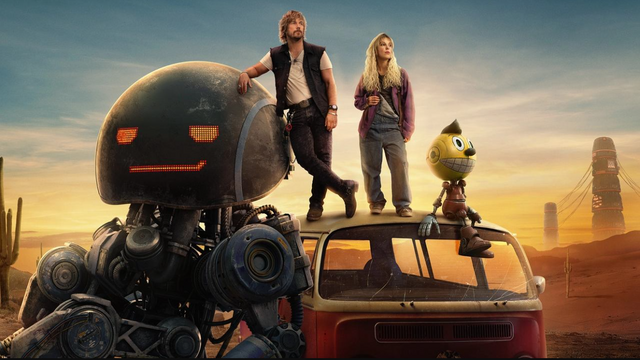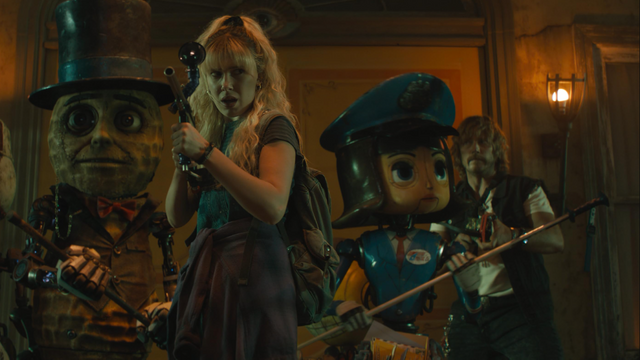The Electric State: Beauty without Soul

source
The mediocrity of Anthony Russo and Joe Russo outside of Marvel, along with the mediocrity of Milly Bobby Brown outside of Stranger Things, teamed up to see if they could make a relevant film, and the result of that union is a film for a Netflix streaming service titled The Electric State, based on a graphic novel that apparently has very little to it. That graphic novel only borrowed its aesthetic and a few other elements.
Electric State is a film with an approximate budget of $320 million, a budget that's on par with the Russian Brothers' Marvel films, especially Infinity War or Endgame, as well as a film like Batman vs. Superman, Justice League, or, why not, James Cameron's Avatar films of that magnitude. I'm talking about the one that had a budget for this film, which isn't going to be released in theaters, but is intended solely for home consumption on a streaming service, on your phone, or on your TV in your room. It's an experience to watch while locked in your house, and it's worth it. Well, as I mentioned at the beginning, this film is based on original material written by Simon Stalenhag. Said material is a graphic novel to which he ultimately contributes the story as well as the artistic aspect. Something that has stood out about his work is precisely its aesthetic, as it portrays the 1990s.

source
With a completely retro-futuristic look, and when I saw the aesthetic of his art, I automatically thought of a series I had seen, which, for me, was the best series on Prime Video. A series that, in my eyes and from my perspective, will end up becoming, or perhaps already is, a cult series. Tales from the Loop is one of the best science fiction series ever made. It's available on Prime Video, and the making, creation, and development of that series was completely inspired by the artwork and visual design that Simon Stalenhag presented in his novel Electric State. His art inspired the creation of Tails from the Loop. It also led the Ruso Brothers, for example, to join the Netflix project to adapt Simon's graphic novel. However, the Ruso Brothers ended up saying that the story, the narrative told in that graphic novel, was very difficult to adapt into a two-hour film. They were going to be inspired by the aesthetic aspect, taking a few things from the original narrative and basically recreating and telling a story.
Completely different and not at all faithful to the true story of the graphic novel, The Electric State is a 1-hour-55-minute film starring Milly Bobby Brown, who seems to be getting work only if she works with Netflix because she tried to join Warner Bros.' B-movie Godzilla versus Kong and Godzilla: King of the Monsters, but that's as far as she goes. Then we have Cris Prat. Also in this film, as a second lead, who never stops being Cris Prat, and the Electric State film boasts humor and style, action, and quality, for example, in the dialogue. How they're going to do what's called the "delivery of the conversations" and the on-screen performances is very similar to the productions that the Russo Brothers have made at Marvel Studios. They're not creative, and it's become very clear when, outside of Marvel, they've wanted to have their own products that were Terrible if you give them good material, material that's fairly well scripted and a great producer, like maybe Kevin Fishy, telling them about these limits.
Conclusion
The Electric State appears to be a product that prioritizes visual aesthetics and technical impact over a profound or risky narrative. While the criticism we analyze has an evidently sarcastic and biting tone (with some hate), it is also based on real and verifiable points, such as the difficulty the Russo Brothers have had replicating their success outside of Marvel, the repetitive use of certain actors who don't always deliver fresh or memorable performances, and a growing trend at Netflix to opt for visual blockbusters that sacrifice substance.
Adapting a work like Simon Stålenhag's—which doesn't have a traditional plot—is a challenge, and if it's done solely by sticking to the retro-futuristic aesthetic without providing a powerful story, then the criticism is justified: it's more of a pretty shell than a memorable film.
That said, the tone of the criticism can be unnecessarily destructive and even contemptuous at times, especially toward the actors. This undermines its objectivity. A more balanced critique would have acknowledged the visual successes, the creative risks and the intention to experiment with a different narrative, while also pointing out the structural gaps.
I never read any of the source material so I wasn't one of the people that was upset about them deviating greatly from it. I knew nothing about it coming into this and unlike it seems almost everyone else that watched this, I quite enjoyed it.
It's predictable and kind of dumb, sure. But I thought it was cute and funny and really enjoyed it. I am in the minority as far as this opinion is concerned though, I am aware of this.
Te resumo el post, la verdad que tambien me gusto jejejjeje